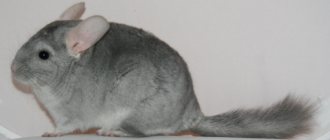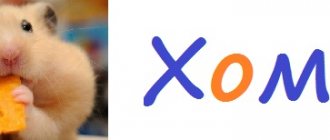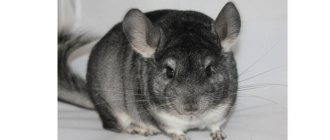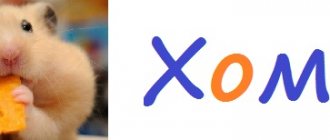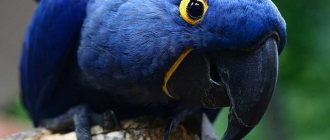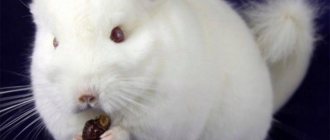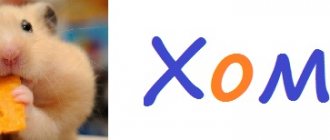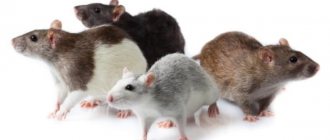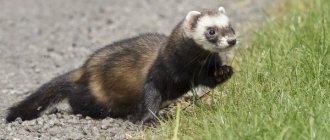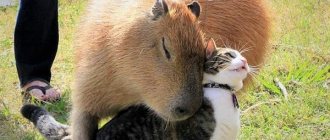03/24/2021 11,445 Chinchillas
Author: Olga
So that the chinchilla could survive in its natural habitat, nature gave it fur of modest colors. The most recognizable color of a chinchilla's coat is white on the tummy, gray on the back and sides. This is the basic color, the so-called standard. Shades from light ash to graphite are the framework within which this gray classic is designed. The breeders decided to change the scenario of nature and the chinchillas themselves, as they were a century ago.
[Hide]
One is gray, the other is white - colors
Experiments on crossing individuals have been ongoing for several decades in order to obtain skins of extraordinary beauty. The result of this work was such new shades as violet, diamond, sapphire, ebony...
Let's figure out exactly what shades these and other, no less spectacular, names encode. Let's find out who the degu and the Siberian chinchilla are. Does Siberian coloring even exist? What does the color of a degu look like? But before we answer these questions, let's talk about the basic gray color.
Strictly speaking, what we call “gray”, meaning the color of a wild rodent, is actually a more complex, three-color color. Just imagine a hair pigmented from tip to root with black, white and gray. It is very difficult to notice the zonality of coloring, because these hairs are located extremely close to each other.
The three-level coloring of the hairs, invisible to the eye, creates an amazing optical effect. – Depending on the depth of black, the purity of white and the shade of gray, the result is fur colored gray with varying degrees of intensity.
The highlight of the color is the silver tint or the so-called veil. These are the short-tailed chinchilla and the long-tailed chinchilla. – This is the name of two species of rodents of the chinchilla family. And the colors that these chinchilla breeds have in nature are standard.
The standard color has four types. Each type corresponds to the degree of color saturation: moderately dark standard, dark standard, extra-dark standard and medium standard. The most valuable is considered to be an individual of the extra-dark standard color.
The restrained beauty of the wild chinchilla is challenged by its domesticated relatives. They are expanding the number of species of rodents in the chinchilla family. And belonging to one or another depends not on the length of the tail, but on the color.
Popular colors of chinchillas
So, today many individuals of various stripes have been bred, the most popular of which are:
- White Wilson. Wilsons have several types: from milky to dark silver. All Wilsons have black eyes and a white tail tip. Two white Wilsons are not planted because two Wilsons have little chance of producing viable young.
- Pastel. Varieties of colors: light pastel, dark pastel, extra-dark pastel, medium pastel. Pastel colored animals darken with age.
- Black velvet. These animals have a white belly, black back and sides. The muzzle of the animal Black Velvet is also black. The more clearly the color contrast is manifested, the higher the individual is valued. Wilsons are often chosen as a pair for Black Velvet. And like the Wilsons, two Black Velvets are not planted together.
- Ebony. The ebony gene affects the degree of coloration of the tummy. If the animal's belly fur matches the color of its main fur, then it is real ebony.
- Homobeige. Homobeige fur is distinguished by uniform coloring. Homobeige animals have pink ears.
- Heterobeige. Unlike homobeige, heterobeige coats are colored unevenly: the tips of the hairs, like the undercoat, are darker than the main tone.
- Degu. Degu is a dwarf chinchilla. In nature, degus “wear” brown fur coats with a yellowish or grayish tint. It doesn't sound as impressive as, say, sapphire and diamond. And it doesn’t look as radical as, for example, an albino. However, breeders liked the small degu chinchillas. They try to recreate the degu color by crossing individuals of different colors.
Possible variations that result from crossing
When crossing animals of different colors, different colors are obtained. The number of possible options is so large that it is simply impossible to list them. Among them are White Velvet, Heteroebony, Homoebony and others.
Rare and spectacular chinchilla colors
Rare colors of rodents of the chinchilla family are:
- Sapphire. A blue chinchilla with a pearly white belly and pink ears: meet Sapphire. Individuals of the Sapphire color have low viability, so they are rare in their pure form.
- Royal Persian Angora. This is a long-tailed chinchilla, whose colors can be any. The most valuable types of Royal Persian Angoras are diamond and sapphire. The “royal” feature of Angoras is their long, beautiful hair. Thanks to their rich wool, Royal Angoras, even of standard color, look luxurious.
- White and pink coats belong to animals with beige and white genes. These genes make themselves felt in different ways, which is why there are several subspecies of pink and white colors. So, the white-pink color is both white, with beige marks, and beige, with white spots. But no matter what subspecies the white-pink color is classified as, the color of its owner’s ears will always be pink. To produce pink and white cubs, both the female and the male must be carriers of four genes at once. This is why white and pink colors are not common. Breeders really like individuals of this color, because the white and pink shade has a royal look!
- Violet. Animals of this color do not always have purple fur. The fur coat can be gray or purple. But a shade of violet is always present in the pigmentation of the nose. In order not to lose the violet gene, violet-colored individuals are planted exclusively with each other. However, sometimes breeders deviate from this rule, breeding individuals in shades of violet and black velvet.
So who is the Siberian chinchilla? Having listed a large number of colors, we still haven’t met the Siberian. It turns out that the Siberian chinchilla is a breed of cat. Attempts to find a “Siberian” shade (or anything else “Siberian”) in rodents of the chinchilla family are in vain.
But Siberian cats “borrowed” their zone-colored hairs from rodents. The surprisingly soft fur of Siberian cats added similarity to animals from different orders.
Features and Benefits
Chinchilla fur is thick, up to 3 cm long. It does not smell, since there are no sweat glands on the animal’s skin. The three-color color transition from gray to blue and white is effective. The softness and airiness of chinchilla cannot be compared with any other. Despite the volume, the coat is light, pleasant to the touch, and reliably protects from wind and frost.
Wear resistance is low. A chinchilla fur coat is not intended for everyday wear; it is easily wiped off when it comes into contact with objects - jewelry, a bag. For this reason, it is rarely worn, trying not to combine it with accessories that could damage the fur.
Genetic color calculator for chinchillas
The colors of chinchillas are very diverse. How to breed an individual of the desired color? Understanding the complex interweaving of pet genes can be quite difficult. A tool such as a genetic calculator comes to the aid of a chinchilla breeder. Using a genetic calculator, you can determine which color offspring is most likely to be born.
So, using this calculator, you can calculate that a Homoebony mother and a Homoebony dad will have almost 64% probability of producing Gomoebony cubs. There is a 22% chance that their babies will have the Extra-Dark Ebony color. The possibility of these parents having Ebony-dark babies is 10%. And in only 4% of cases, such a couple gives birth to Ebony-light and Ebony-medium cubs.
Models
Simple models are sewn from chinchilla fur so that attention is directed to the beauty of the fur. Experienced designers skillfully select skins, creating spectacular color transitions and luxurious stripes. By sewing them crosswise, long fur coats are created.
Most often, fashion designers offer short sheepskin coats, vests, capes, and boleros. The absence of a hood can be explained simply - the fur rubs and loses its attractiveness.
Video “Chinchilla colors”
This video features White and Pink Chinchilla, Angora Chinchilla, Beige Chinchilla, White Wilson. Here you can also see individuals of such colors as Brown Velvet, Homoebony, Homobeige, White Velvet, White Sapphire. The authors of the video also did not forget about the colors Albino, White Violet, Blue Diamond, Pastel, Ebony, Violet, Homobeige Sapphire, Sapphire, Black Velvet.
Was this article helpful?
Thank you for your opinion!
The article was useful. Please share the information with your friends.
Yes (75.00%)
No (25.00%)
X
Please write what is wrong and leave recommendations on the article
Cancel reply
Rate the benefit of the article: Rate the author ( 5 votes, average: 4.80 out of 5)
Discuss the article:
Selection by length
Young girls prefer short models. Older women choose long ones, preferring midi ones. This is explained not only by the price of the product, but also by the practicality of use.
See also
Top Ten Simple Head Scarf Ideas
Short
For those who lead an active lifestyle, a fur coat above mid-thigh is good. Waist-length short fur coats, short jackets, vests, and chinchilla boleros look great.
But it is necessary to wear fur carefully, since even on short models it deteriorates when it comes into contact with different surfaces.
Average
The length from mid-thigh to knee is most often chosen. A midi chinchilla fur coat can hide figure imperfections, and in a fitted version, highlight the advantages.
Models made from sheared chinchilla are cheaper, but look impressive when they are above the knee.
Long
Modern designers create full-length fur coats extremely rarely, since the price of such a product is high and practicality is low. The hem soon takes on an unpresentable appearance due to scuffs, the clothes need to be somehow revived - recut, altered.
Stylish looks
The type of clothing worn with a chinchilla fur coat depends on its length. With a chic, floor-length look, an evening dress and high-heeled shoes are appropriate. A short one perfectly complements a business style - a pencil skirt or trouser suit in combination with stylish shoes with heels or high wedges.
See also
Beautiful models of fluffy dresses, what to wear them with and how to choose the length
A chinchilla fur cape, like a long fur coat, is a choice for an evening outfit. Jackets and vests are combined with youth style - jeans, skinny trousers, high shoes with flat soles or heels.
The only requirement for all looks is that clothes worn with a chinchilla must be made from high-quality fabrics and have impeccable cut and tailoring.
Theme: Heteroebony
Quick transition Basic colors, one gene Up
- Navigation
- Cabinet
- Private messages
- Subscriptions
- Who's on the site
- Search the forum
- Forum home page
- Forum
- All about chinchillas, general questions
- Who are Chinchillas? Newbie questions
- Care and maintenance at home
- Cages, display cases and their arrangement
- Food and treats, all about feeding and nutrition
- Features of behavior, observations
- Congratulations on your newborn!
- Breeding chinchillas - mating, pregnancy, childbirth
- Finally born! Photos of little chinchillas
- Bad feeling. Diseases and treatment
- Diseases, Treatment of chinchillas
- Veterinarians, veterinary clinics and pharmacies
- Colors and genetics
- Colors and genetics, general questions
- Basic colors, one gene
- Simple colors, two genes
- Complex colors, more than 2 genes
- About pleasant things
- I'm happy - I have a new pet, chinchillomania is progressing!
- We are such beautiful chinchillas!
- SALE OF CHINCHILLAS AND RELATED PRODUCTS (paid section)
- Rules for using this section. Read for everyone.
- Food and products for chinchillas from CHINCHILLA WORLD
- Chinchillas for sale from a breeder in Moscow Chinchillas aged 0 to 2 years
- Chinchillas aged from 2 years to 5 years
- Chinchillas aged 6 to 8 years
- Chinchillas aged 8 years and older
- Chinchillas are not for breeding, as pets
- Chinchillas for sale from a breeder in St. Petersburg
- Chinchillas aged 0 to 2 years
- Chinchillas aged from 2 years to 5 years
- Chinchillas aged 6 to 8 years
- Chinchillas aged 8 years and older
- Chinchillas are not for breeding, as pets
- Sale of chinchillas from a breeder in Russia (except Moscow and St. Petersburg)
- Chinchillas aged 0 to 2 years
- Chinchillas aged from 2 years to 5 years
- Chinchillas aged 6 to 8 years
- Chinchillas aged 8 years and older
- Chinchillas are not for breeding, as pets
- Sale of chinchillas from a breeder in Ukraine
- Chinchillas aged 0 to 2 years
- Chinchillas aged from 2 years to 5 years
- Chinchillas aged 6 to 8 years
- Chinchillas aged 8 years and older
- Chinchillas are not for breeding, as pets
- Selling chinchillas from a breeder in other countries
- Chinchillas aged 0 to 2 years
- Chinchillas aged from 2 years to 5 years
- Chinchillas aged 6 to 8 years
- Chinchillas aged 8 years and older
- Chinchillas are not for breeding, as pets
- Selling non-own breeding chinchillas
- Selling chinchillas from forum newcomers
- Products for chinchillas
- Cages, display cases from manufacturers and pet stores Moscow
- Saint Petersburg
- Other cities in Russia
- Ukraine
- Other countries
- Accessories for chinchillas from manufacturers and pet stores
- Moscow
- Saint Petersburg
- Other cities in Russia
- Ukraine
- Other countries
- Food, additives, treats
- Moscow
- Saint Petersburg
- Other cities in Russia
- Ukraine
- Other countries
- REQUESTS FOR PURCHASE, EXCHANGE, GIVEAWAY, etc.
- I will buy a chinchilla, purchase requests
- I'll give away a chinchilla, Exchange, Joint couples
- Delivery from beyond Bug.
- BIRD MARKET (free chinchilla sales section)
- Sale of chinchillas in Moscow and Moscow Region
- Sale of chinchillas in St. Petersburg and Leningrad Region
- Sale of chinchillas in other cities of Russia
- Selling chinchillas in other countries
- OTHER SALES (not chinchillas)
- Sale of used goods
- Sales of other pets
- PEOPLE AND ANIMALS.
- World of Lemurs Lemurs, all about Lemurs
- Sale of lemurs
- Hedgehog World
- Keeping and breeding hedgehogs
- Varieties of hedgehog colors
- Nutrition and feeding of hedgehogs
- Sale of hedgehogs
- My home zoo, pets.
- Sugar glider
- Rabbits: decorative, dwarf
- Guinea pigs
- Rats
- Hamsters, mice, degus
- Dogs
- Cats, cats, kittens.
- Other favorites
- Exotic animals
- My hobbies
- Music
- Vacations, travel
- Food
- Movies
- Painting
- Needlework.
- Photo
- Flowers
- Sport
- Programs
- Design
- Fishing
- Literature
- Collecting, other hobbies
>Colors and breeds of chinchillas
Over the years, thanks to selective breeding, chinchillas have received many colors. Here we have collected the most common of them with photographs and descriptions.
Useful materials:
- Poodle haircut photo Rostov Types of haircuts A classic, discreet look or a bright and extraordinary haircut will allow you to create a unique style for your…
- Basset Hound photo and description Characteristics and standards The description of a Basset Hound dog must meet the following parameters: The height at the withers of the bitch reaches…
- House for chinchillas Types, shapes and types of houses for chinchillas What types of houses for chinchillas can be found: from…
- Black Scottish Fold photo Description of the breed The external resemblance to British cats is not accidental, because they are considered close relatives. But the differences...
What to wear with a chinchilla fur coat in the 2021-2022 season
But if you become the owner of a chinchilla fur coat, the question involuntarily arises of what to wear with a chinchilla fur coat.
- First of all, it is necessary to exclude other accents, leaving this right to the fur coat.
- There is no need to add complex fur design; simple and brief additions will suffice. This model will serve as an excellent clothing option for a weekend evening or special occasions.
- No less stylish is the use of such a model with a casual ensemble, for example, with jeans and a beautiful pullover.
Coco Chanel said that truly luxurious things should be “only” for fun and always a little sloppy.
[Total: 4 Average: 2.5/5]
How to choose the right one
Due to inexperience, the buyer may confuse a chinchilla with the fur of a Rex rabbit. Therefore, when choosing, follow several tips and features:
- chinchilla fur is light;
- the cost of a fur coat is high;
- the length of the rabbit skin is 3 times longer;
- You can distinguish the fur by touch - in a chinchilla it is much softer;
- the product has a wave-like shape due to dips at the junctions of the skins;
- you should pay attention to the smell - a painted rabbit smells like paint;
- You must ask the seller for a quality certificate and a purchase warranty card.
Results
Breeding chinchillas is a very profitable business. However, in order to become an experienced breeder, you should take into account not only the breeds of chinchillas and their colors, but also know all the intricacies of the care and nutrition of these magnificent animals.
Gray and beige rodents are easier to breed, they are more common, and their babies are cheaper than, for example, sapphire and purple ones. Crossing and breeding chinchillas is an extremely complex process, so it needs to be approached wisely and only done by those people who are truly interested in it. You should not do this for the sake of banal profit, since nothing good will come from such a business.
Not only breeders, but also scientists around the world are engaged in breeding new breeds. They are driven to this by the popularity of rodents not only as pets, but also by their breeding as specimens to obtain valuable fur.
Keeping a chinchilla at home is not very easy, but it is worth it. The animals love their owners very much and treat them with tenderness and love. Breeders advise purchasing chinchillas in pairs, because there is nothing more pleasant than watching their games, affection, love and friendship, which a person can only envy.
Source
Storage and care rules
To care for a fur coat, perform a number of actions:
- Set aside a place for it in the closet so that there is no contact with other clothes.
- Carry out annual cleaning in a specialized dry cleaner.
- Brush the fur periodically with a soft brush.
- If you are not wearing socks, ventilate your fur coat.
- The cover and hanger are chosen according to the size of the clothing.
- The fur product is completely dried before being placed in the closet.
Drying a fur coat near a radiator or heater is contraindicated.
Chinchilla breeds: Shades and breeds of animals with photographs and names
Many believe that chinchilla breeds are fiction, and that the animals can be exclusively gray, the way they are most often seen in pet store windows and in photos on the Internet. However, this opinion is wrong. Breeders have been working for decades to ensure that the breeds and shades of these funny rodents only increase.
Below we will introduce you to the varieties of chinchilla colors and their breeds offered in nurseries.
